Zara Fashion Industry's Impact on Global Warming: A Detailed Report
VerifiedAdded on 2020/12/29
|11
|3110
|60
Report
AI Summary
This report examines the significant impact of the Zara fashion industry on global warming, highlighting critical issues related to business ethics and sustainability. It evaluates the carbon footprint, the implications of fast fashion, and the use of synthetic fabrics. The report analyzes the impact of fashion clothing production on governments, producers, and consumers, proposing recommendations to address global and local environmental issues. It identifies strategic and operational dimensions for implementing eco-friendly practices, including challenges and opportunities within the industry. The report emphasizes the need for sustainable practices, including the use of recycled materials and the adoption of ethical production methods to reduce the negative environmental effects of the fashion industry and promote a more sustainable future for the planet. The research also focuses on the importance of government regulations, producer responsibilities, and consumer behavior in driving positive change within the fashion industry.

The Impact of Fashion apparel industry
on Global warming
on Global warming
Paraphrase This Document
Need a fresh take? Get an instant paraphrase of this document with our AI Paraphraser

Table of Contents
INTRODUCTION...........................................................................................................................3
1. Critical evaluation and identification of the issues which are arrived from the Zara Fashion
brand in order to maintain the business ethics and sustainability...............................................3
2. Implication of Fashion clothing productions on government, producers and consumers.
Developing the recommendations that address the global and local issues op a considering
various perspectives....................................................................................................................5
Identify both the strategic and operational/practice dimensions involved in implementing your
eco friendly fashionable products...............................................................................................6
Opportunities and challenges that are needed to address the ethics and sustainability issues
within this industry as proposed in your recommendations........................................................7
CONCLUSION................................................................................................................................8
REFERENCES..............................................................................................................................10
INTRODUCTION...........................................................................................................................3
1. Critical evaluation and identification of the issues which are arrived from the Zara Fashion
brand in order to maintain the business ethics and sustainability...............................................3
2. Implication of Fashion clothing productions on government, producers and consumers.
Developing the recommendations that address the global and local issues op a considering
various perspectives....................................................................................................................5
Identify both the strategic and operational/practice dimensions involved in implementing your
eco friendly fashionable products...............................................................................................6
Opportunities and challenges that are needed to address the ethics and sustainability issues
within this industry as proposed in your recommendations........................................................7
CONCLUSION................................................................................................................................8
REFERENCES..............................................................................................................................10
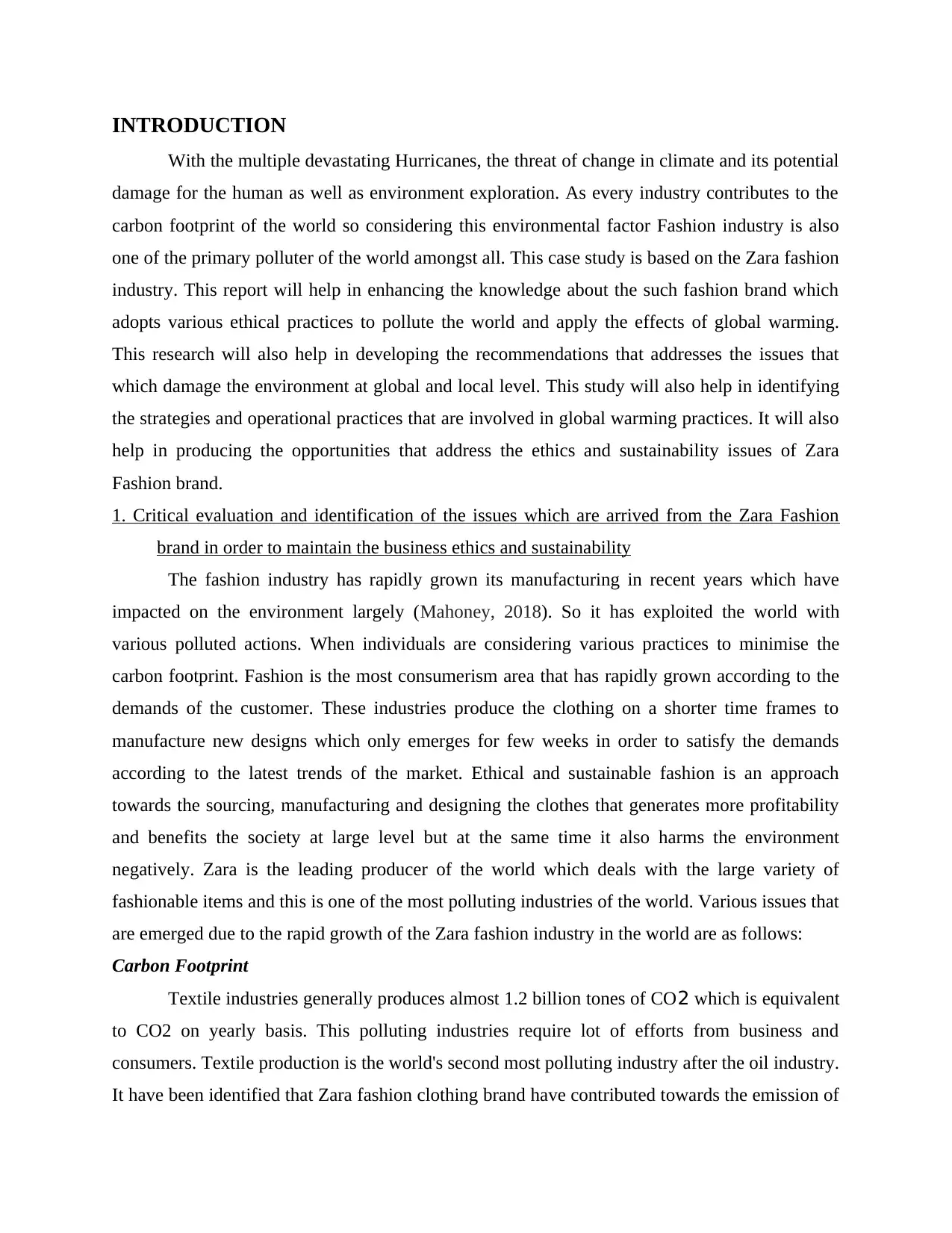
INTRODUCTION
With the multiple devastating Hurricanes, the threat of change in climate and its potential
damage for the human as well as environment exploration. As every industry contributes to the
carbon footprint of the world so considering this environmental factor Fashion industry is also
one of the primary polluter of the world amongst all. This case study is based on the Zara fashion
industry. This report will help in enhancing the knowledge about the such fashion brand which
adopts various ethical practices to pollute the world and apply the effects of global warming.
This research will also help in developing the recommendations that addresses the issues that
which damage the environment at global and local level. This study will also help in identifying
the strategies and operational practices that are involved in global warming practices. It will also
help in producing the opportunities that address the ethics and sustainability issues of Zara
Fashion brand.
1. Critical evaluation and identification of the issues which are arrived from the Zara Fashion
brand in order to maintain the business ethics and sustainability
The fashion industry has rapidly grown its manufacturing in recent years which have
impacted on the environment largely (Mahoney, 2018). So it has exploited the world with
various polluted actions. When individuals are considering various practices to minimise the
carbon footprint. Fashion is the most consumerism area that has rapidly grown according to the
demands of the customer. These industries produce the clothing on a shorter time frames to
manufacture new designs which only emerges for few weeks in order to satisfy the demands
according to the latest trends of the market. Ethical and sustainable fashion is an approach
towards the sourcing, manufacturing and designing the clothes that generates more profitability
and benefits the society at large level but at the same time it also harms the environment
negatively. Zara is the leading producer of the world which deals with the large variety of
fashionable items and this is one of the most polluting industries of the world. Various issues that
are emerged due to the rapid growth of the Zara fashion industry in the world are as follows:
Carbon Footprint
Textile industries generally produces almost 1.2 billion tones of CO2 which is equivalent
to CO2 on yearly basis. This polluting industries require lot of efforts from business and
consumers. Textile production is the world's second most polluting industry after the oil industry.
It have been identified that Zara fashion clothing brand have contributed towards the emission of
With the multiple devastating Hurricanes, the threat of change in climate and its potential
damage for the human as well as environment exploration. As every industry contributes to the
carbon footprint of the world so considering this environmental factor Fashion industry is also
one of the primary polluter of the world amongst all. This case study is based on the Zara fashion
industry. This report will help in enhancing the knowledge about the such fashion brand which
adopts various ethical practices to pollute the world and apply the effects of global warming.
This research will also help in developing the recommendations that addresses the issues that
which damage the environment at global and local level. This study will also help in identifying
the strategies and operational practices that are involved in global warming practices. It will also
help in producing the opportunities that address the ethics and sustainability issues of Zara
Fashion brand.
1. Critical evaluation and identification of the issues which are arrived from the Zara Fashion
brand in order to maintain the business ethics and sustainability
The fashion industry has rapidly grown its manufacturing in recent years which have
impacted on the environment largely (Mahoney, 2018). So it has exploited the world with
various polluted actions. When individuals are considering various practices to minimise the
carbon footprint. Fashion is the most consumerism area that has rapidly grown according to the
demands of the customer. These industries produce the clothing on a shorter time frames to
manufacture new designs which only emerges for few weeks in order to satisfy the demands
according to the latest trends of the market. Ethical and sustainable fashion is an approach
towards the sourcing, manufacturing and designing the clothes that generates more profitability
and benefits the society at large level but at the same time it also harms the environment
negatively. Zara is the leading producer of the world which deals with the large variety of
fashionable items and this is one of the most polluting industries of the world. Various issues that
are emerged due to the rapid growth of the Zara fashion industry in the world are as follows:
Carbon Footprint
Textile industries generally produces almost 1.2 billion tones of CO2 which is equivalent
to CO2 on yearly basis. This polluting industries require lot of efforts from business and
consumers. Textile production is the world's second most polluting industry after the oil industry.
It have been identified that Zara fashion clothing brand have contributed towards the emission of
⊘ This is a preview!⊘
Do you want full access?
Subscribe today to unlock all pages.

Trusted by 1+ million students worldwide
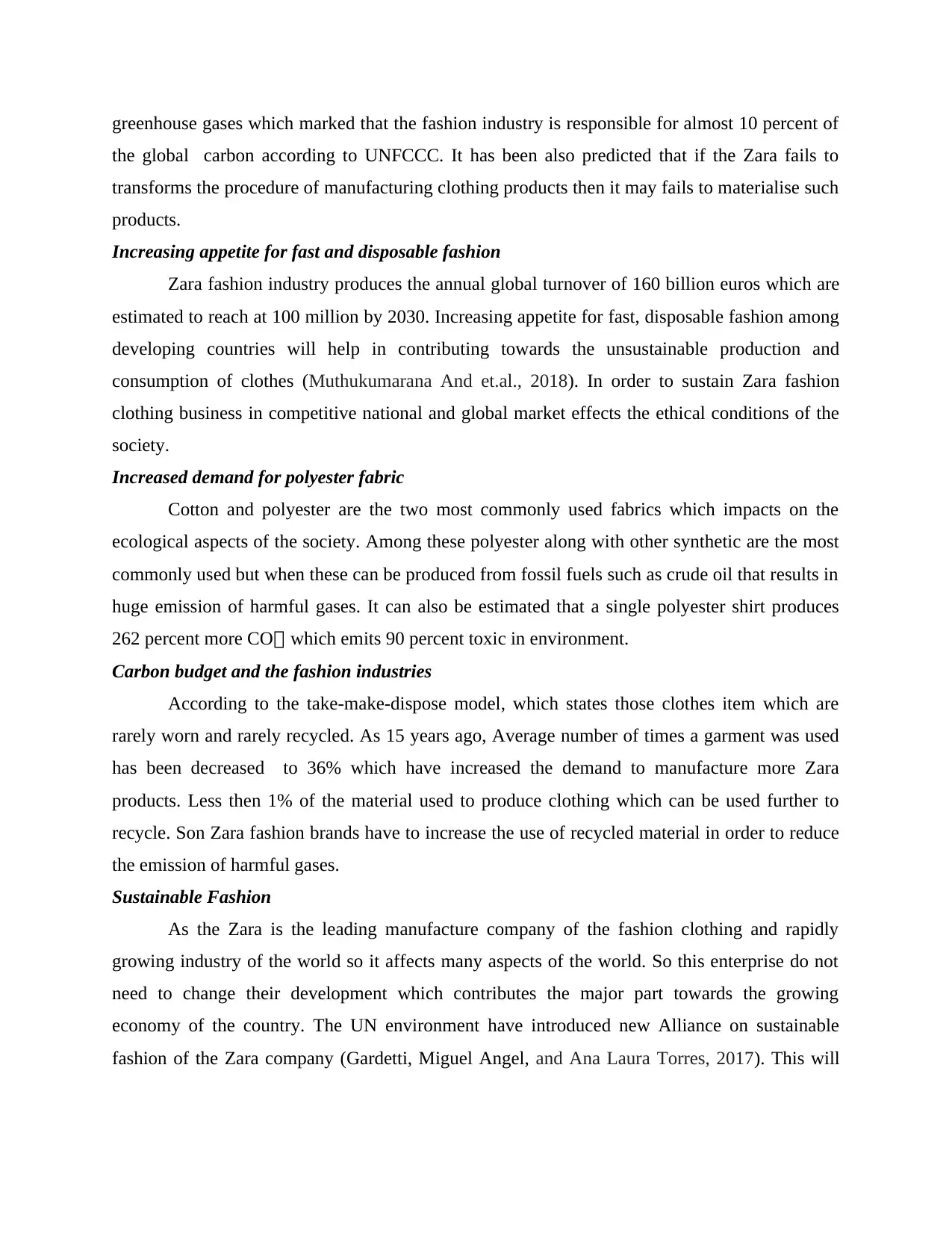
greenhouse gases which marked that the fashion industry is responsible for almost 10 percent of
the global carbon according to UNFCCC. It has been also predicted that if the Zara fails to
transforms the procedure of manufacturing clothing products then it may fails to materialise such
products.
Increasing appetite for fast and disposable fashion
Zara fashion industry produces the annual global turnover of 160 billion euros which are
estimated to reach at 100 million by 2030. Increasing appetite for fast, disposable fashion among
developing countries will help in contributing towards the unsustainable production and
consumption of clothes (Muthukumarana And et.al., 2018). In order to sustain Zara fashion
clothing business in competitive national and global market effects the ethical conditions of the
society.
Increased demand for polyester fabric
Cotton and polyester are the two most commonly used fabrics which impacts on the
ecological aspects of the society. Among these polyester along with other synthetic are the most
commonly used but when these can be produced from fossil fuels such as crude oil that results in
huge emission of harmful gases. It can also be estimated that a single polyester shirt produces
262 percent more CO which emits 90 percent toxic in environment.
Carbon budget and the fashion industries
According to the take-make-dispose model, which states those clothes item which are
rarely worn and rarely recycled. As 15 years ago, Average number of times a garment was used
has been decreased to 36% which have increased the demand to manufacture more Zara
products. Less then 1% of the material used to produce clothing which can be used further to
recycle. Son Zara fashion brands have to increase the use of recycled material in order to reduce
the emission of harmful gases.
Sustainable Fashion
As the Zara is the leading manufacture company of the fashion clothing and rapidly
growing industry of the world so it affects many aspects of the world. So this enterprise do not
need to change their development which contributes the major part towards the growing
economy of the country. The UN environment have introduced new Alliance on sustainable
fashion of the Zara company (Gardetti, Miguel Angel, and Ana Laura Torres, 2017). This will
the global carbon according to UNFCCC. It has been also predicted that if the Zara fails to
transforms the procedure of manufacturing clothing products then it may fails to materialise such
products.
Increasing appetite for fast and disposable fashion
Zara fashion industry produces the annual global turnover of 160 billion euros which are
estimated to reach at 100 million by 2030. Increasing appetite for fast, disposable fashion among
developing countries will help in contributing towards the unsustainable production and
consumption of clothes (Muthukumarana And et.al., 2018). In order to sustain Zara fashion
clothing business in competitive national and global market effects the ethical conditions of the
society.
Increased demand for polyester fabric
Cotton and polyester are the two most commonly used fabrics which impacts on the
ecological aspects of the society. Among these polyester along with other synthetic are the most
commonly used but when these can be produced from fossil fuels such as crude oil that results in
huge emission of harmful gases. It can also be estimated that a single polyester shirt produces
262 percent more CO which emits 90 percent toxic in environment.
Carbon budget and the fashion industries
According to the take-make-dispose model, which states those clothes item which are
rarely worn and rarely recycled. As 15 years ago, Average number of times a garment was used
has been decreased to 36% which have increased the demand to manufacture more Zara
products. Less then 1% of the material used to produce clothing which can be used further to
recycle. Son Zara fashion brands have to increase the use of recycled material in order to reduce
the emission of harmful gases.
Sustainable Fashion
As the Zara is the leading manufacture company of the fashion clothing and rapidly
growing industry of the world so it affects many aspects of the world. So this enterprise do not
need to change their development which contributes the major part towards the growing
economy of the country. The UN environment have introduced new Alliance on sustainable
fashion of the Zara company (Gardetti, Miguel Angel, and Ana Laura Torres, 2017). This will
Paraphrase This Document
Need a fresh take? Get an instant paraphrase of this document with our AI Paraphraser
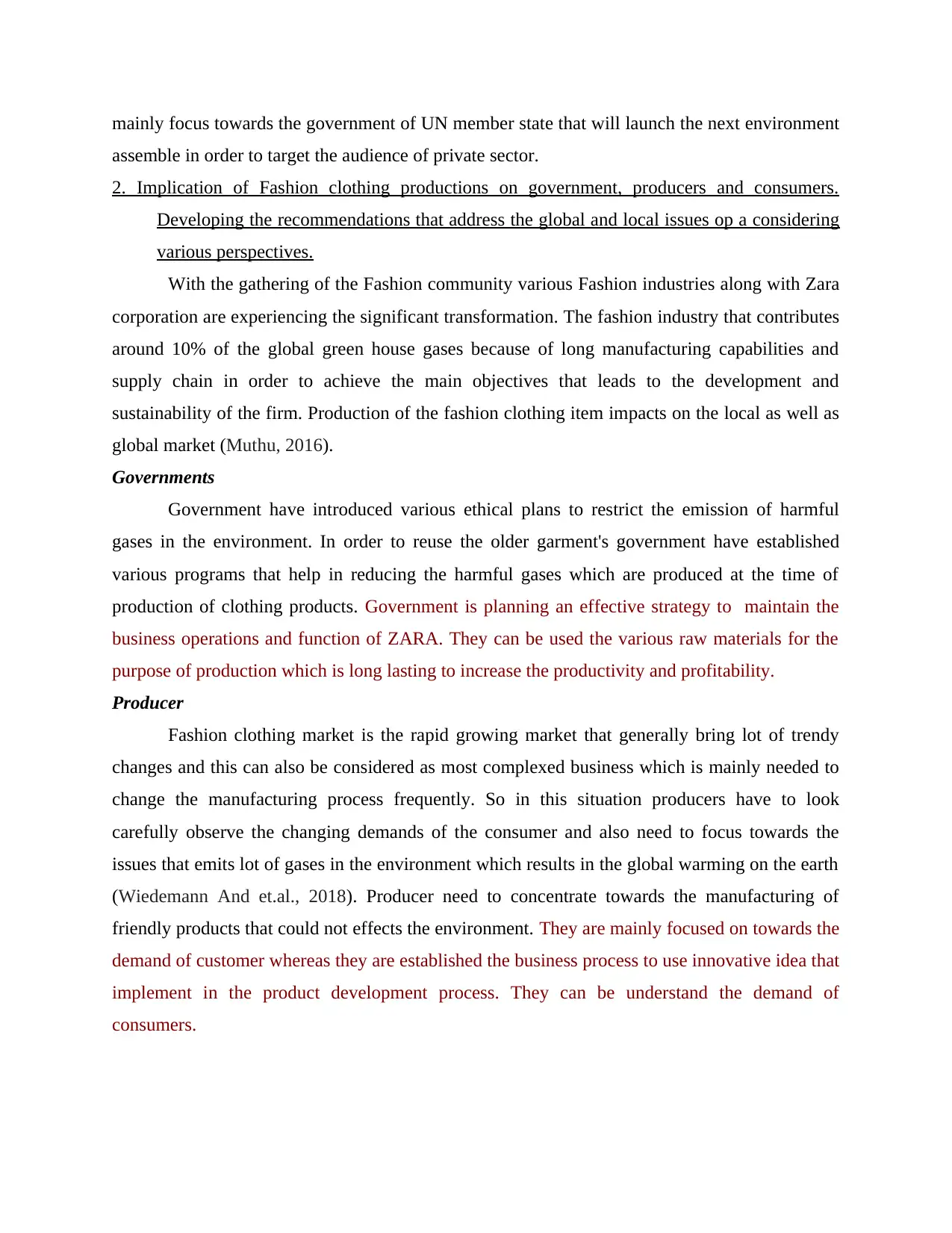
mainly focus towards the government of UN member state that will launch the next environment
assemble in order to target the audience of private sector.
2. Implication of Fashion clothing productions on government, producers and consumers.
Developing the recommendations that address the global and local issues op a considering
various perspectives.
With the gathering of the Fashion community various Fashion industries along with Zara
corporation are experiencing the significant transformation. The fashion industry that contributes
around 10% of the global green house gases because of long manufacturing capabilities and
supply chain in order to achieve the main objectives that leads to the development and
sustainability of the firm. Production of the fashion clothing item impacts on the local as well as
global market (Muthu, 2016).
Governments
Government have introduced various ethical plans to restrict the emission of harmful
gases in the environment. In order to reuse the older garment's government have established
various programs that help in reducing the harmful gases which are produced at the time of
production of clothing products. Government is planning an effective strategy to maintain the
business operations and function of ZARA. They can be used the various raw materials for the
purpose of production which is long lasting to increase the productivity and profitability.
Producer
Fashion clothing market is the rapid growing market that generally bring lot of trendy
changes and this can also be considered as most complexed business which is mainly needed to
change the manufacturing process frequently. So in this situation producers have to look
carefully observe the changing demands of the consumer and also need to focus towards the
issues that emits lot of gases in the environment which results in the global warming on the earth
(Wiedemann And et.al., 2018). Producer need to concentrate towards the manufacturing of
friendly products that could not effects the environment. They are mainly focused on towards the
demand of customer whereas they are established the business process to use innovative idea that
implement in the product development process. They can be understand the demand of
consumers.
assemble in order to target the audience of private sector.
2. Implication of Fashion clothing productions on government, producers and consumers.
Developing the recommendations that address the global and local issues op a considering
various perspectives.
With the gathering of the Fashion community various Fashion industries along with Zara
corporation are experiencing the significant transformation. The fashion industry that contributes
around 10% of the global green house gases because of long manufacturing capabilities and
supply chain in order to achieve the main objectives that leads to the development and
sustainability of the firm. Production of the fashion clothing item impacts on the local as well as
global market (Muthu, 2016).
Governments
Government have introduced various ethical plans to restrict the emission of harmful
gases in the environment. In order to reuse the older garment's government have established
various programs that help in reducing the harmful gases which are produced at the time of
production of clothing products. Government is planning an effective strategy to maintain the
business operations and function of ZARA. They can be used the various raw materials for the
purpose of production which is long lasting to increase the productivity and profitability.
Producer
Fashion clothing market is the rapid growing market that generally bring lot of trendy
changes and this can also be considered as most complexed business which is mainly needed to
change the manufacturing process frequently. So in this situation producers have to look
carefully observe the changing demands of the consumer and also need to focus towards the
issues that emits lot of gases in the environment which results in the global warming on the earth
(Wiedemann And et.al., 2018). Producer need to concentrate towards the manufacturing of
friendly products that could not effects the environment. They are mainly focused on towards the
demand of customer whereas they are established the business process to use innovative idea that
implement in the product development process. They can be understand the demand of
consumers.
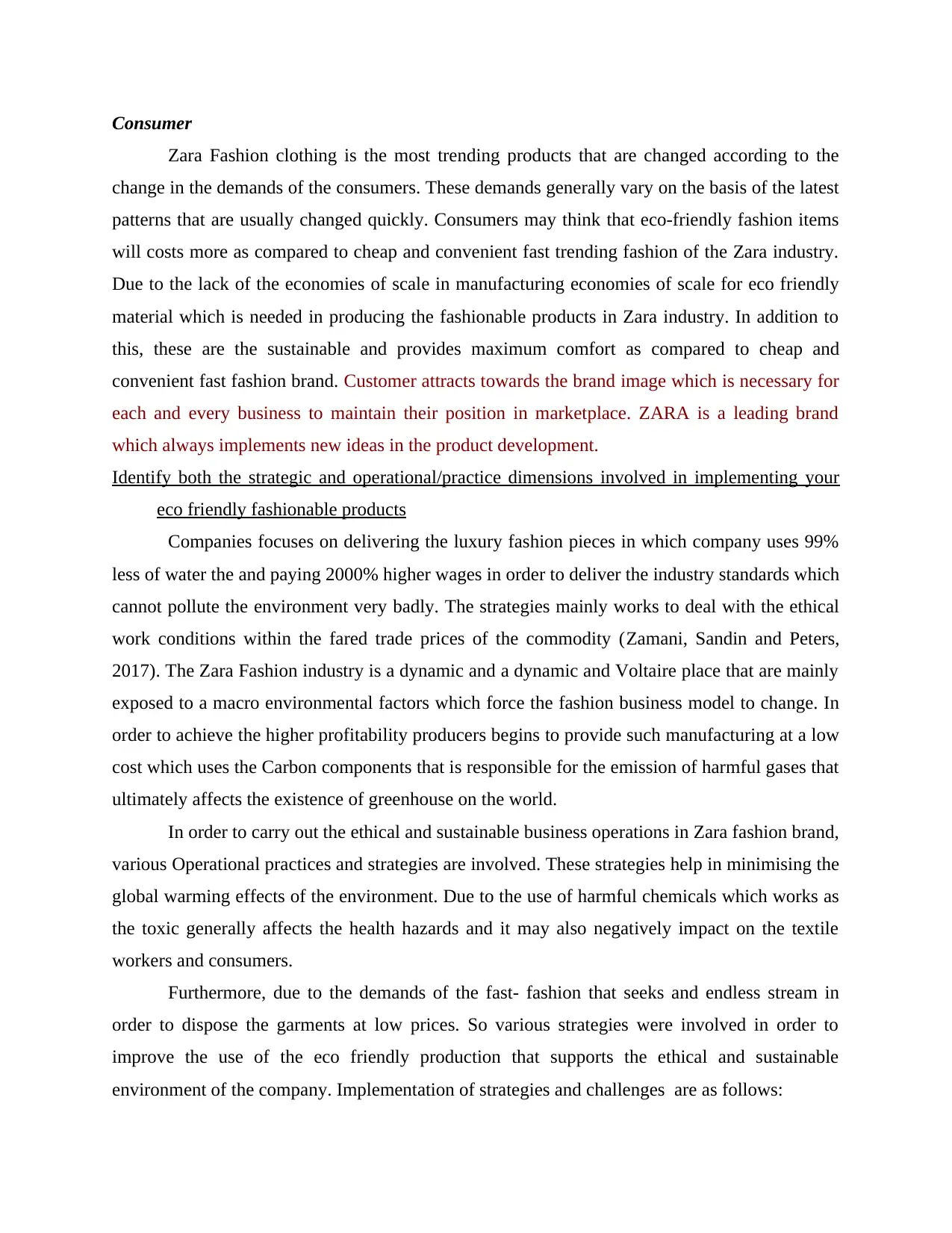
Consumer
Zara Fashion clothing is the most trending products that are changed according to the
change in the demands of the consumers. These demands generally vary on the basis of the latest
patterns that are usually changed quickly. Consumers may think that eco-friendly fashion items
will costs more as compared to cheap and convenient fast trending fashion of the Zara industry.
Due to the lack of the economies of scale in manufacturing economies of scale for eco friendly
material which is needed in producing the fashionable products in Zara industry. In addition to
this, these are the sustainable and provides maximum comfort as compared to cheap and
convenient fast fashion brand. Customer attracts towards the brand image which is necessary for
each and every business to maintain their position in marketplace. ZARA is a leading brand
which always implements new ideas in the product development.
Identify both the strategic and operational/practice dimensions involved in implementing your
eco friendly fashionable products
Companies focuses on delivering the luxury fashion pieces in which company uses 99%
less of water the and paying 2000% higher wages in order to deliver the industry standards which
cannot pollute the environment very badly. The strategies mainly works to deal with the ethical
work conditions within the fared trade prices of the commodity (Zamani, Sandin and Peters,
2017). The Zara Fashion industry is a dynamic and a dynamic and Voltaire place that are mainly
exposed to a macro environmental factors which force the fashion business model to change. In
order to achieve the higher profitability producers begins to provide such manufacturing at a low
cost which uses the Carbon components that is responsible for the emission of harmful gases that
ultimately affects the existence of greenhouse on the world.
In order to carry out the ethical and sustainable business operations in Zara fashion brand,
various Operational practices and strategies are involved. These strategies help in minimising the
global warming effects of the environment. Due to the use of harmful chemicals which works as
the toxic generally affects the health hazards and it may also negatively impact on the textile
workers and consumers.
Furthermore, due to the demands of the fast- fashion that seeks and endless stream in
order to dispose the garments at low prices. So various strategies were involved in order to
improve the use of the eco friendly production that supports the ethical and sustainable
environment of the company. Implementation of strategies and challenges are as follows:
Zara Fashion clothing is the most trending products that are changed according to the
change in the demands of the consumers. These demands generally vary on the basis of the latest
patterns that are usually changed quickly. Consumers may think that eco-friendly fashion items
will costs more as compared to cheap and convenient fast trending fashion of the Zara industry.
Due to the lack of the economies of scale in manufacturing economies of scale for eco friendly
material which is needed in producing the fashionable products in Zara industry. In addition to
this, these are the sustainable and provides maximum comfort as compared to cheap and
convenient fast fashion brand. Customer attracts towards the brand image which is necessary for
each and every business to maintain their position in marketplace. ZARA is a leading brand
which always implements new ideas in the product development.
Identify both the strategic and operational/practice dimensions involved in implementing your
eco friendly fashionable products
Companies focuses on delivering the luxury fashion pieces in which company uses 99%
less of water the and paying 2000% higher wages in order to deliver the industry standards which
cannot pollute the environment very badly. The strategies mainly works to deal with the ethical
work conditions within the fared trade prices of the commodity (Zamani, Sandin and Peters,
2017). The Zara Fashion industry is a dynamic and a dynamic and Voltaire place that are mainly
exposed to a macro environmental factors which force the fashion business model to change. In
order to achieve the higher profitability producers begins to provide such manufacturing at a low
cost which uses the Carbon components that is responsible for the emission of harmful gases that
ultimately affects the existence of greenhouse on the world.
In order to carry out the ethical and sustainable business operations in Zara fashion brand,
various Operational practices and strategies are involved. These strategies help in minimising the
global warming effects of the environment. Due to the use of harmful chemicals which works as
the toxic generally affects the health hazards and it may also negatively impact on the textile
workers and consumers.
Furthermore, due to the demands of the fast- fashion that seeks and endless stream in
order to dispose the garments at low prices. So various strategies were involved in order to
improve the use of the eco friendly production that supports the ethical and sustainable
environment of the company. Implementation of strategies and challenges are as follows:
⊘ This is a preview!⊘
Do you want full access?
Subscribe today to unlock all pages.

Trusted by 1+ million students worldwide
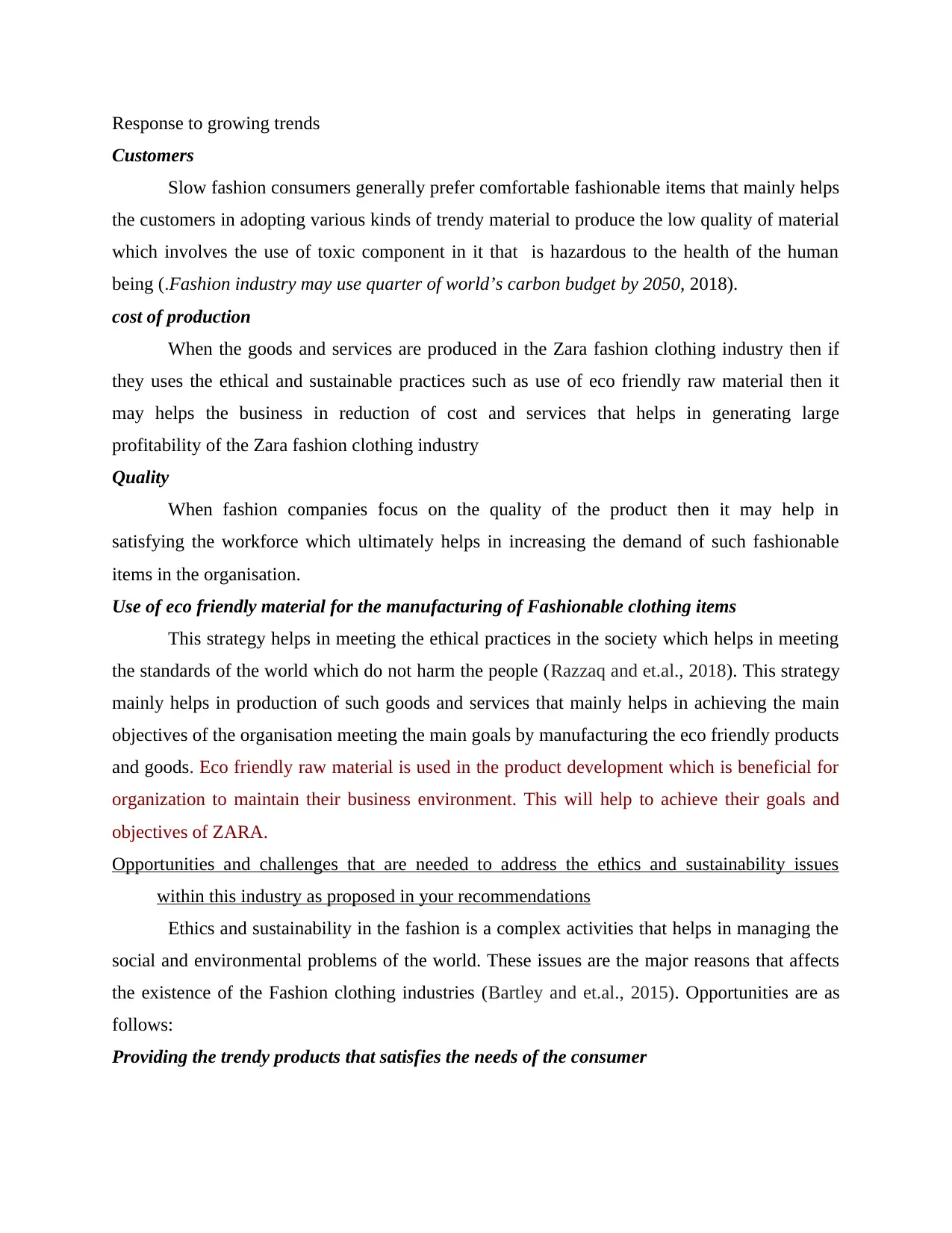
Response to growing trends
Customers
Slow fashion consumers generally prefer comfortable fashionable items that mainly helps
the customers in adopting various kinds of trendy material to produce the low quality of material
which involves the use of toxic component in it that is hazardous to the health of the human
being (.Fashion industry may use quarter of world’s carbon budget by 2050, 2018).
cost of production
When the goods and services are produced in the Zara fashion clothing industry then if
they uses the ethical and sustainable practices such as use of eco friendly raw material then it
may helps the business in reduction of cost and services that helps in generating large
profitability of the Zara fashion clothing industry
Quality
When fashion companies focus on the quality of the product then it may help in
satisfying the workforce which ultimately helps in increasing the demand of such fashionable
items in the organisation.
Use of eco friendly material for the manufacturing of Fashionable clothing items
This strategy helps in meeting the ethical practices in the society which helps in meeting
the standards of the world which do not harm the people (Razzaq and et.al., 2018). This strategy
mainly helps in production of such goods and services that mainly helps in achieving the main
objectives of the organisation meeting the main goals by manufacturing the eco friendly products
and goods. Eco friendly raw material is used in the product development which is beneficial for
organization to maintain their business environment. This will help to achieve their goals and
objectives of ZARA.
Opportunities and challenges that are needed to address the ethics and sustainability issues
within this industry as proposed in your recommendations
Ethics and sustainability in the fashion is a complex activities that helps in managing the
social and environmental problems of the world. These issues are the major reasons that affects
the existence of the Fashion clothing industries (Bartley and et.al., 2015). Opportunities are as
follows:
Providing the trendy products that satisfies the needs of the consumer
Customers
Slow fashion consumers generally prefer comfortable fashionable items that mainly helps
the customers in adopting various kinds of trendy material to produce the low quality of material
which involves the use of toxic component in it that is hazardous to the health of the human
being (.Fashion industry may use quarter of world’s carbon budget by 2050, 2018).
cost of production
When the goods and services are produced in the Zara fashion clothing industry then if
they uses the ethical and sustainable practices such as use of eco friendly raw material then it
may helps the business in reduction of cost and services that helps in generating large
profitability of the Zara fashion clothing industry
Quality
When fashion companies focus on the quality of the product then it may help in
satisfying the workforce which ultimately helps in increasing the demand of such fashionable
items in the organisation.
Use of eco friendly material for the manufacturing of Fashionable clothing items
This strategy helps in meeting the ethical practices in the society which helps in meeting
the standards of the world which do not harm the people (Razzaq and et.al., 2018). This strategy
mainly helps in production of such goods and services that mainly helps in achieving the main
objectives of the organisation meeting the main goals by manufacturing the eco friendly products
and goods. Eco friendly raw material is used in the product development which is beneficial for
organization to maintain their business environment. This will help to achieve their goals and
objectives of ZARA.
Opportunities and challenges that are needed to address the ethics and sustainability issues
within this industry as proposed in your recommendations
Ethics and sustainability in the fashion is a complex activities that helps in managing the
social and environmental problems of the world. These issues are the major reasons that affects
the existence of the Fashion clothing industries (Bartley and et.al., 2015). Opportunities are as
follows:
Providing the trendy products that satisfies the needs of the consumer
Paraphrase This Document
Need a fresh take? Get an instant paraphrase of this document with our AI Paraphraser
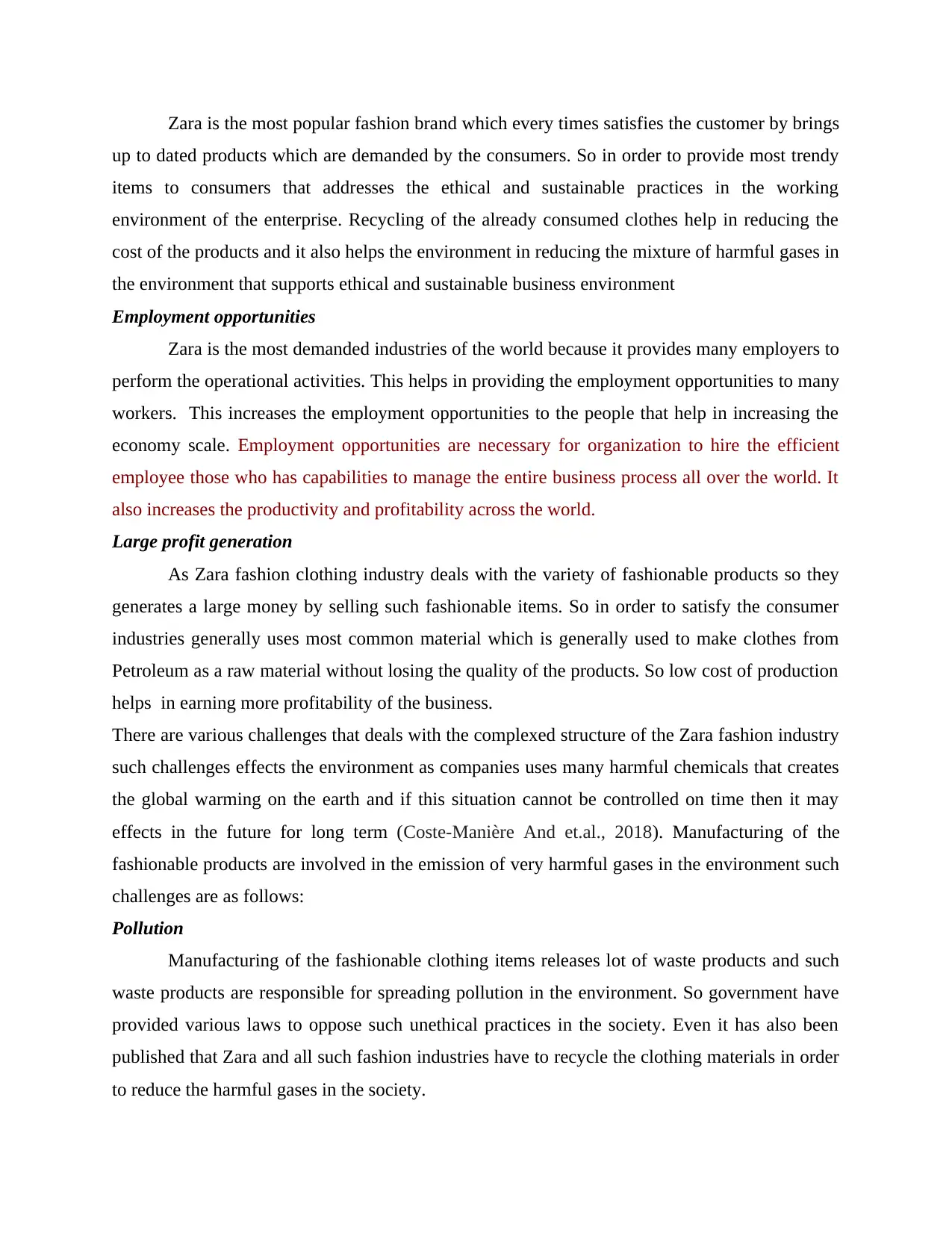
Zara is the most popular fashion brand which every times satisfies the customer by brings
up to dated products which are demanded by the consumers. So in order to provide most trendy
items to consumers that addresses the ethical and sustainable practices in the working
environment of the enterprise. Recycling of the already consumed clothes help in reducing the
cost of the products and it also helps the environment in reducing the mixture of harmful gases in
the environment that supports ethical and sustainable business environment
Employment opportunities
Zara is the most demanded industries of the world because it provides many employers to
perform the operational activities. This helps in providing the employment opportunities to many
workers. This increases the employment opportunities to the people that help in increasing the
economy scale. Employment opportunities are necessary for organization to hire the efficient
employee those who has capabilities to manage the entire business process all over the world. It
also increases the productivity and profitability across the world.
Large profit generation
As Zara fashion clothing industry deals with the variety of fashionable products so they
generates a large money by selling such fashionable items. So in order to satisfy the consumer
industries generally uses most common material which is generally used to make clothes from
Petroleum as a raw material without losing the quality of the products. So low cost of production
helps in earning more profitability of the business.
There are various challenges that deals with the complexed structure of the Zara fashion industry
such challenges effects the environment as companies uses many harmful chemicals that creates
the global warming on the earth and if this situation cannot be controlled on time then it may
effects in the future for long term (Coste-Manière And et.al., 2018). Manufacturing of the
fashionable products are involved in the emission of very harmful gases in the environment such
challenges are as follows:
Pollution
Manufacturing of the fashionable clothing items releases lot of waste products and such
waste products are responsible for spreading pollution in the environment. So government have
provided various laws to oppose such unethical practices in the society. Even it has also been
published that Zara and all such fashion industries have to recycle the clothing materials in order
to reduce the harmful gases in the society.
up to dated products which are demanded by the consumers. So in order to provide most trendy
items to consumers that addresses the ethical and sustainable practices in the working
environment of the enterprise. Recycling of the already consumed clothes help in reducing the
cost of the products and it also helps the environment in reducing the mixture of harmful gases in
the environment that supports ethical and sustainable business environment
Employment opportunities
Zara is the most demanded industries of the world because it provides many employers to
perform the operational activities. This helps in providing the employment opportunities to many
workers. This increases the employment opportunities to the people that help in increasing the
economy scale. Employment opportunities are necessary for organization to hire the efficient
employee those who has capabilities to manage the entire business process all over the world. It
also increases the productivity and profitability across the world.
Large profit generation
As Zara fashion clothing industry deals with the variety of fashionable products so they
generates a large money by selling such fashionable items. So in order to satisfy the consumer
industries generally uses most common material which is generally used to make clothes from
Petroleum as a raw material without losing the quality of the products. So low cost of production
helps in earning more profitability of the business.
There are various challenges that deals with the complexed structure of the Zara fashion industry
such challenges effects the environment as companies uses many harmful chemicals that creates
the global warming on the earth and if this situation cannot be controlled on time then it may
effects in the future for long term (Coste-Manière And et.al., 2018). Manufacturing of the
fashionable products are involved in the emission of very harmful gases in the environment such
challenges are as follows:
Pollution
Manufacturing of the fashionable clothing items releases lot of waste products and such
waste products are responsible for spreading pollution in the environment. So government have
provided various laws to oppose such unethical practices in the society. Even it has also been
published that Zara and all such fashion industries have to recycle the clothing materials in order
to reduce the harmful gases in the society.
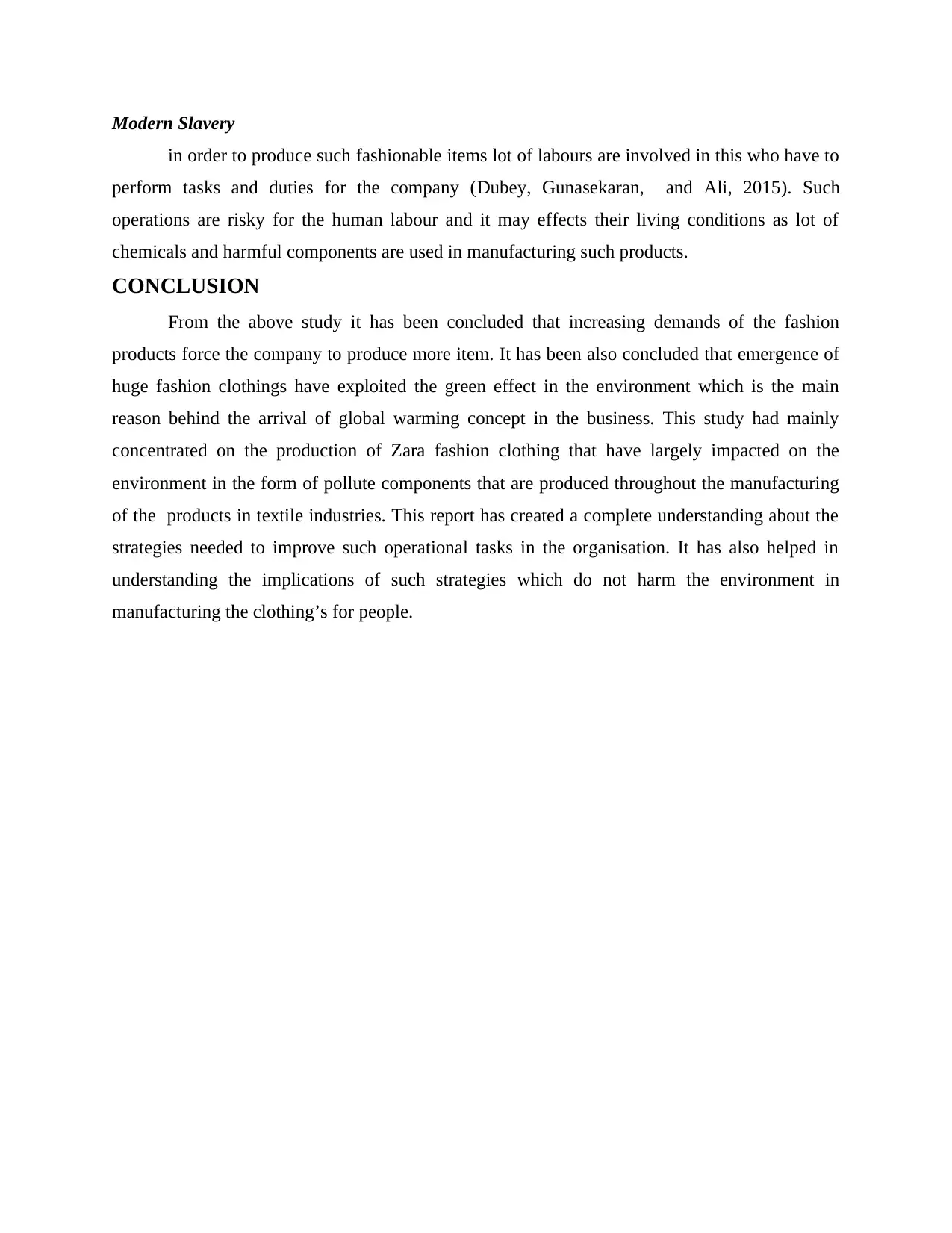
Modern Slavery
in order to produce such fashionable items lot of labours are involved in this who have to
perform tasks and duties for the company (Dubey, Gunasekaran, and Ali, 2015). Such
operations are risky for the human labour and it may effects their living conditions as lot of
chemicals and harmful components are used in manufacturing such products.
CONCLUSION
From the above study it has been concluded that increasing demands of the fashion
products force the company to produce more item. It has been also concluded that emergence of
huge fashion clothings have exploited the green effect in the environment which is the main
reason behind the arrival of global warming concept in the business. This study had mainly
concentrated on the production of Zara fashion clothing that have largely impacted on the
environment in the form of pollute components that are produced throughout the manufacturing
of the products in textile industries. This report has created a complete understanding about the
strategies needed to improve such operational tasks in the organisation. It has also helped in
understanding the implications of such strategies which do not harm the environment in
manufacturing the clothing’s for people.
in order to produce such fashionable items lot of labours are involved in this who have to
perform tasks and duties for the company (Dubey, Gunasekaran, and Ali, 2015). Such
operations are risky for the human labour and it may effects their living conditions as lot of
chemicals and harmful components are used in manufacturing such products.
CONCLUSION
From the above study it has been concluded that increasing demands of the fashion
products force the company to produce more item. It has been also concluded that emergence of
huge fashion clothings have exploited the green effect in the environment which is the main
reason behind the arrival of global warming concept in the business. This study had mainly
concentrated on the production of Zara fashion clothing that have largely impacted on the
environment in the form of pollute components that are produced throughout the manufacturing
of the products in textile industries. This report has created a complete understanding about the
strategies needed to improve such operational tasks in the organisation. It has also helped in
understanding the implications of such strategies which do not harm the environment in
manufacturing the clothing’s for people.
⊘ This is a preview!⊘
Do you want full access?
Subscribe today to unlock all pages.

Trusted by 1+ million students worldwide
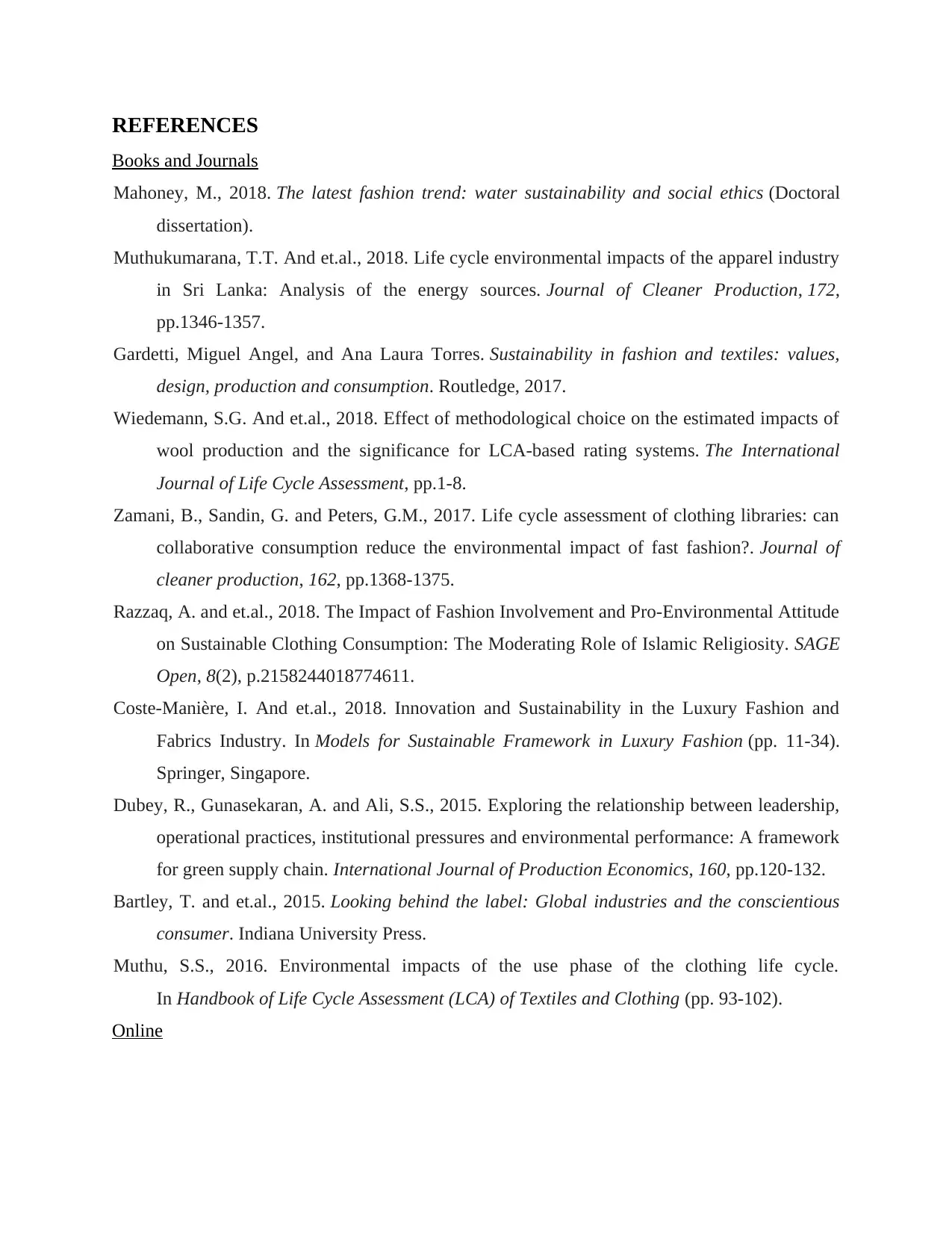
REFERENCES
Books and Journals
Mahoney, M., 2018. The latest fashion trend: water sustainability and social ethics (Doctoral
dissertation).
Muthukumarana, T.T. And et.al., 2018. Life cycle environmental impacts of the apparel industry
in Sri Lanka: Analysis of the energy sources. Journal of Cleaner Production, 172,
pp.1346-1357.
Gardetti, Miguel Angel, and Ana Laura Torres. Sustainability in fashion and textiles: values,
design, production and consumption. Routledge, 2017.
Wiedemann, S.G. And et.al., 2018. Effect of methodological choice on the estimated impacts of
wool production and the significance for LCA-based rating systems. The International
Journal of Life Cycle Assessment, pp.1-8.
Zamani, B., Sandin, G. and Peters, G.M., 2017. Life cycle assessment of clothing libraries: can
collaborative consumption reduce the environmental impact of fast fashion?. Journal of
cleaner production, 162, pp.1368-1375.
Razzaq, A. and et.al., 2018. The Impact of Fashion Involvement and Pro-Environmental Attitude
on Sustainable Clothing Consumption: The Moderating Role of Islamic Religiosity. SAGE
Open, 8(2), p.2158244018774611.
Coste-Manière, I. And et.al., 2018. Innovation and Sustainability in the Luxury Fashion and
Fabrics Industry. In Models for Sustainable Framework in Luxury Fashion (pp. 11-34).
Springer, Singapore.
Dubey, R., Gunasekaran, A. and Ali, S.S., 2015. Exploring the relationship between leadership,
operational practices, institutional pressures and environmental performance: A framework
for green supply chain. International Journal of Production Economics, 160, pp.120-132.
Bartley, T. and et.al., 2015. Looking behind the label: Global industries and the conscientious
consumer. Indiana University Press.
Muthu, S.S., 2016. Environmental impacts of the use phase of the clothing life cycle.
In Handbook of Life Cycle Assessment (LCA) of Textiles and Clothing (pp. 93-102).
Online
Books and Journals
Mahoney, M., 2018. The latest fashion trend: water sustainability and social ethics (Doctoral
dissertation).
Muthukumarana, T.T. And et.al., 2018. Life cycle environmental impacts of the apparel industry
in Sri Lanka: Analysis of the energy sources. Journal of Cleaner Production, 172,
pp.1346-1357.
Gardetti, Miguel Angel, and Ana Laura Torres. Sustainability in fashion and textiles: values,
design, production and consumption. Routledge, 2017.
Wiedemann, S.G. And et.al., 2018. Effect of methodological choice on the estimated impacts of
wool production and the significance for LCA-based rating systems. The International
Journal of Life Cycle Assessment, pp.1-8.
Zamani, B., Sandin, G. and Peters, G.M., 2017. Life cycle assessment of clothing libraries: can
collaborative consumption reduce the environmental impact of fast fashion?. Journal of
cleaner production, 162, pp.1368-1375.
Razzaq, A. and et.al., 2018. The Impact of Fashion Involvement and Pro-Environmental Attitude
on Sustainable Clothing Consumption: The Moderating Role of Islamic Religiosity. SAGE
Open, 8(2), p.2158244018774611.
Coste-Manière, I. And et.al., 2018. Innovation and Sustainability in the Luxury Fashion and
Fabrics Industry. In Models for Sustainable Framework in Luxury Fashion (pp. 11-34).
Springer, Singapore.
Dubey, R., Gunasekaran, A. and Ali, S.S., 2015. Exploring the relationship between leadership,
operational practices, institutional pressures and environmental performance: A framework
for green supply chain. International Journal of Production Economics, 160, pp.120-132.
Bartley, T. and et.al., 2015. Looking behind the label: Global industries and the conscientious
consumer. Indiana University Press.
Muthu, S.S., 2016. Environmental impacts of the use phase of the clothing life cycle.
In Handbook of Life Cycle Assessment (LCA) of Textiles and Clothing (pp. 93-102).
Online
Paraphrase This Document
Need a fresh take? Get an instant paraphrase of this document with our AI Paraphraser

Fashion industry may use quarter of world’s carbon budget by 2050. 2018. [online]. Available
through:<https://www.downtoearth.org.in/news/environment/fashion-industry-may-use-
quarter-of-world-s-carbon-budget-by-2050-61183>
through:<https://www.downtoearth.org.in/news/environment/fashion-industry-may-use-
quarter-of-world-s-carbon-budget-by-2050-61183>
1 out of 11
Related Documents
Your All-in-One AI-Powered Toolkit for Academic Success.
+13062052269
info@desklib.com
Available 24*7 on WhatsApp / Email
![[object Object]](/_next/static/media/star-bottom.7253800d.svg)
Unlock your academic potential
Copyright © 2020–2025 A2Z Services. All Rights Reserved. Developed and managed by ZUCOL.





